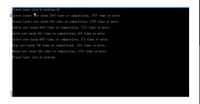
Database System Concepts
7th Edition
ISBN: 9780078022159
Author: Abraham Silberschatz Professor, Henry F. Korth, S. Sudarshan
Publisher: McGraw-Hill Education
expand_more
expand_more
format_list_bulleted
Question
Sort
Realize direct insertion sort, half insertion sort, bubble sort, quick sort, select sort, heap sort and merge sort.
- Raw data is generated randomly.
- For different problem size, output the number of comparisons and moves required by various sorting
algorithms - When the program is running, input the problem size from the keyboard, the source data is randomly generated by the system, and then output the comparison times and movement times required by various sorting algorithms under this problem scale.
. In this problem above it show not be different programs to each sort but one program for all the sorts mention..and after running the program it should ask the the user to input problem size.do it in C language..the output should be like the attachment picture

Transcribed Image Text:Please input size of problem:100
Direct insert ort needs 2670 times of comparisions. 2757 times of moves
Binary insert sort needs 504 times of comparisions. 2758 times of moves
Bubble sort needs 4829 times of comparisions. 7713 times of moves
Quick sort needs 681 times of comparisions. 476 times of moves
Select sort needs 4950 times of comparisions. 273 times of moves
Heap sort needs 749 times of comparisions, 1091 times of moves
lerge sort needs 543 times of comparisions, 1376 times of moves
Please input size of problem:
Expert Solution
This question has been solved!
Explore an expertly crafted, step-by-step solution for a thorough understanding of key concepts.
This is a popular solution
Trending nowThis is a popular solution!
Step by stepSolved in 2 steps

Knowledge Booster
Learn more about
Need a deep-dive on the concept behind this application? Look no further. Learn more about this topic, computer-science and related others by exploring similar questions and additional content below.Similar questions
- part e, f, and g are considers 1 question, please answer themarrow_forwardLanguage: C++ Write a Program with Comments for your code to improve quick sort. The quick sort algorithm presented in the ClassNotes-Sorting, it selects the first element in the list as the pivot. Revise it by selecting the median among the first, middle, and last elements in the list.Explain your Outputs or Answers for the following: (A) Analyze your algorithm, and give the results using order notation. (B) Give a list of n items (for example, an array of 10 integers) representing a scenario. Please compile your answers in a file including all source code with comments, Explain your running Outputs or Answers in (A) and (B). Quicksort that was mentioned in the ClassNotes: #include <iostream>using namespace std; // Function prototypesvoid quickSort(int list[], int arraySize);void quickSort(int list[], int first, int last);int partition(int list[], int first, int last); void quickSort(int list[], int arraySize){quickSort(list, 0, arraySize - 1);} void quickSort(int…arrow_forwardSort Realize direct insertion sort, half insertion sort, bubble sort, quick sort, select sort, heap sort and merge sort. Raw data is generated randomly. For different problem size, output the number of comparisons and moves required by various sorting algorithms When the program is running, input the problemsize from the keyboard, the source data is randomly generated by the system, and then output the comparison times and movement times required by various sorting algorithms under this problem scale.. Do this in C++ language..do it according to the above requirementarrow_forward
- Computer Science Using Java, write a simple Insertion Sort program that can read in integers from a text file (line by line) and sort them into another text file. Use inFile and outFile for the input and output files, respectively. Also make sure that the algorithm keeps track of the comparisons and exchanges performed by the sort so that they may be printed out in the console after the sort is completedarrow_forwardWrite a version of the sequential search algorithm that can be used to search a sorted list. Write a program to test the sequential search algorithm. Use either the function bubbleSort or insertionSort to sort the list before the search. Your program should prompt the user to enter 10 digits and then prompt the user to enter a digit to search - if the list contains this digit, output its position to the console: x is found at position y If the digit is not contained in the list, output the following: x is not in the listarrow_forward
arrow_back_ios
arrow_forward_ios
Recommended textbooks for you
 Database System ConceptsComputer ScienceISBN:9780078022159Author:Abraham Silberschatz Professor, Henry F. Korth, S. SudarshanPublisher:McGraw-Hill Education
Database System ConceptsComputer ScienceISBN:9780078022159Author:Abraham Silberschatz Professor, Henry F. Korth, S. SudarshanPublisher:McGraw-Hill Education Starting Out with Python (4th Edition)Computer ScienceISBN:9780134444321Author:Tony GaddisPublisher:PEARSON
Starting Out with Python (4th Edition)Computer ScienceISBN:9780134444321Author:Tony GaddisPublisher:PEARSON Digital Fundamentals (11th Edition)Computer ScienceISBN:9780132737968Author:Thomas L. FloydPublisher:PEARSON
Digital Fundamentals (11th Edition)Computer ScienceISBN:9780132737968Author:Thomas L. FloydPublisher:PEARSON C How to Program (8th Edition)Computer ScienceISBN:9780133976892Author:Paul J. Deitel, Harvey DeitelPublisher:PEARSON
C How to Program (8th Edition)Computer ScienceISBN:9780133976892Author:Paul J. Deitel, Harvey DeitelPublisher:PEARSON Database Systems: Design, Implementation, & Manag...Computer ScienceISBN:9781337627900Author:Carlos Coronel, Steven MorrisPublisher:Cengage Learning
Database Systems: Design, Implementation, & Manag...Computer ScienceISBN:9781337627900Author:Carlos Coronel, Steven MorrisPublisher:Cengage Learning Programmable Logic ControllersComputer ScienceISBN:9780073373843Author:Frank D. PetruzellaPublisher:McGraw-Hill Education
Programmable Logic ControllersComputer ScienceISBN:9780073373843Author:Frank D. PetruzellaPublisher:McGraw-Hill Education

Database System Concepts
Computer Science
ISBN:9780078022159
Author:Abraham Silberschatz Professor, Henry F. Korth, S. Sudarshan
Publisher:McGraw-Hill Education

Starting Out with Python (4th Edition)
Computer Science
ISBN:9780134444321
Author:Tony Gaddis
Publisher:PEARSON

Digital Fundamentals (11th Edition)
Computer Science
ISBN:9780132737968
Author:Thomas L. Floyd
Publisher:PEARSON

C How to Program (8th Edition)
Computer Science
ISBN:9780133976892
Author:Paul J. Deitel, Harvey Deitel
Publisher:PEARSON

Database Systems: Design, Implementation, & Manag...
Computer Science
ISBN:9781337627900
Author:Carlos Coronel, Steven Morris
Publisher:Cengage Learning

Programmable Logic Controllers
Computer Science
ISBN:9780073373843
Author:Frank D. Petruzella
Publisher:McGraw-Hill Education